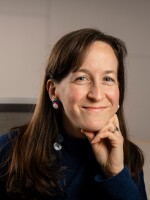When local school districts aren’t performing, parents typically turn to school boards or parent-teacher organizations to bring about change. But in one small Fresno County city, education advocates are thinking bigger, trying to enact a much bolder and more ambitious kind of transformation.
It’s 8 a.m. in the city of Huron and the Chevron on Lassen Avenue is bumping. Between drivers filling their tanks, cashier Lydia Ramirez serves kids loading their backpacks with breakfast burritos, candy, and pizza. These kids are on their way to the middle school down the street. But high school students? Ramirez says they hardly ever come in.
“I don't see them in the morning," Ramirez says. "They have to get their bus. They have to get up early.”
Her 16-year-old daughter is one of them. She wakes up at 5 a.m. for a bus ride that lasts over an hour. Her high school is 20 miles away—in Coalinga. The cities share the Coalinga-Huron Unified School District. Ramirez says it’ll be a relief when her daughter graduates.
“It’s my last daughter,” she says. “I’m like, I’m almost out, she doesn’t have to get up early.”

Ramirez isn’t the only one who’s frustrated. Hundreds of Huron parents are. It’s not just the commute: School performance is low and students are dropping out. So Huron’s parents came up with a plan: Break away from Coalinga and create their own school district. It’s a long shot, but the state could approve the new district later this summer—a decision Ramirez would support.
“Oh heck yeah, even if my kid's not in the high school anymore I would, because I suffered that when I went to high school,” she says. “Everybody did.”
Huron’s tiny. Blink and you’ve driven through it. Primarily an ag town, it’s one of the poorest cities in California. Almost 100 percent of its 7,000 residents are Latino. Coalinga, home to 17,000 residents, feels more suburban. It’s bigger, whiter, and more affluent, even though both cities are poorer than the state as a whole. These differences are one reason Ben Silva, chairman of the Huron Reorganization Committee, says it’s time to secede.
“Our future is not gonna be left to somebody else,” Silva says. “It's gonna be left to us. That's the point of it.”
Huron has an elementary and middle school, but Coalinga has the high school. Twelve years ago, Silva says Huron tried to build a high school, but the Coalinga-majority school board voted it down. That’s when Huron said: Let’s just do this ourselves. The committee circulated a petition to create Huron Unified—and it got far more than the 250 signatures it needed.
“Two weeks after turning them in, we still had people coming up wanting to sign,” he says. “We were like, ‘it's already gone, we got enough, but when it's time to vote, we'll remember you.’”

The state gives the current school district low grades, and online rankings place it in the bottom 5 percent of the state. Its dropout rate is higher than the state average, too. Silva argues Huron’s high schoolers can do better closer to home, without spending hours of their day commuting.
“These kids aren't going to Harvard,” Silva says. “If you had every kid going to Ivy League, you wouldn't hear from us. There's a reason that we have to be engaged.”
Silva and other Huron advocates also claim their schools don’t receive their fair share of district funding, and that their kids get fewer opportunities than Coalinga’s. We couldn’t confirm that, though, because both the superintendent’s office and the school board refused to be interviewed for this story.
How do Coalinga residents feel about this? I walked around downtown to find out. The handful of parents I spoke to said they’d never heard of the discrimination the Huron committee claims. One even said Huron students receive special treatment.
Many hadn’t even heard of the proposed split. But those who had generally support it.
“I think it would be better for [Huron],” says Vanessa Rodriguez, a Coalinga mother of eight. “It would be less gang violence around Coalinga. You’ve got the Huron kids that come and do trouble—they’re the ones that influence the other kids around here.”
“I think it would be a good thing for Huron and the community,” says Laura Cajero-Beemus, a Coalinga mother of three getting her hair done in a Coalinga salon. “Doing that, they'd be open to more grants available and to help grow the community.
The state department of education will give the plan a thumbs up or down in July. But that’s not the end. If the proposal moves forward, spokesman Robert Oakes says it’ll still go up for a vote in the next election.
“This is a local decision. Starts at the local level, ends at the local level. We're in the middle,” Oakes says. “It’s democracy in action. They get to decide.”

School district reorganizations don’t happen very often. In the last 20 years, only two of 13 requests made it past the state and local elections.
New districts need to check a lot of boxes. They need enough students to be viable. They also have to prove they can afford it, while still delivering quality education. The Huron committee says they’ve got all that covered.
There is, however, one potential point of weakness: “You also cannot discriminate or promote racial or ethnic segregation,” Oakes says.
Because Huron and Coalinga are so racially different, the resulting school districts would be more segregated than the current one, though they’d all still be majority Latino.
Is that more important than school performance or local identity? The state will decide—then, it could go back to the voters.




